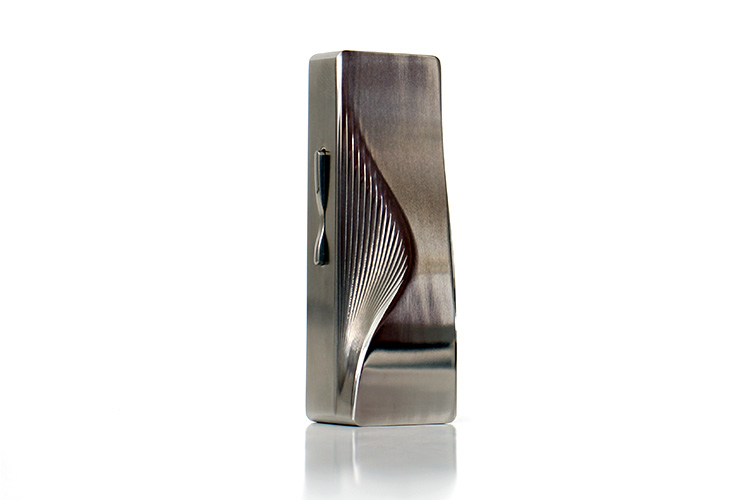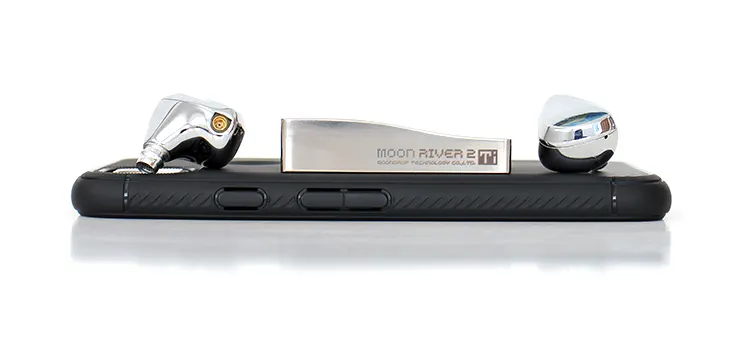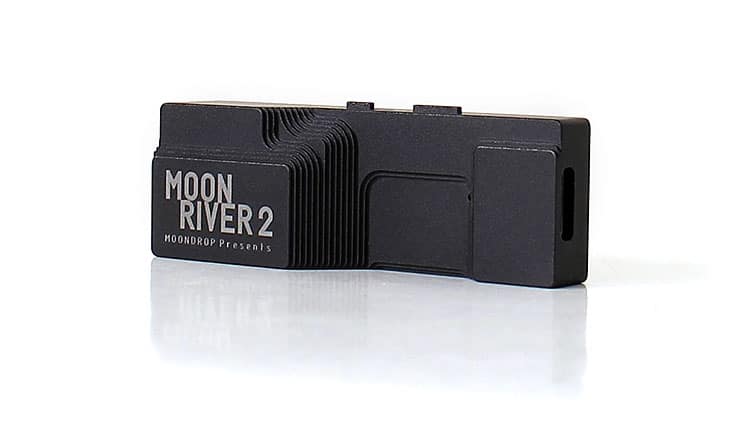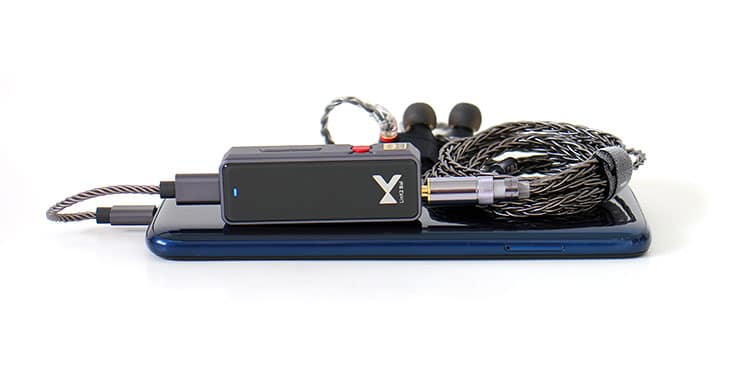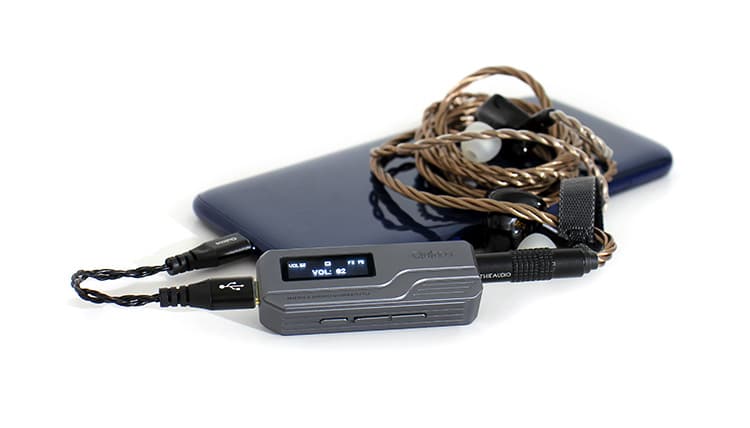Synergy
Power
The headphones I had lying around my desktop setup were HIFIMAN Arya V2, and the other was the HE-X4 which was evaluated some weeks ago. Both cans are somewhat hard to drive and both were supplied ample amounts of power from the MOONRIVER 2: TI.
This is a dongle that, once again, seems underrated as far as specifications although the listed max power output of 280mW and a 4Vrms out specification is not too feeble. I would also say that a 300Ω can like the SIVGA SV023 would do okay though output drops to 53mw at that impedance, however.
The MOONRIVER 2: TI was designed to be a portable device and it does supply ample power but at the same time consumes lots of it and it runs on the high side of warm. You can improve battery life by using sensitive IEMs and using moderation on the volume but that’s all you can do.
Perhaps MOONDROP should consider an eco mode within the app in that once applied, the system only recognizes one DAC chip and shuts down the other to save on gas. You can shut off the LED indicator within the app which can give the same effect but only up to a certain level.
Pairing
One successful pairing was with a set of FiiO FH15 IEMs and the reason seemed to be the ample amounts of power the MOONRIVER 2: TI supplied which in turn gave ample amounts of bass control to this set. Their FD5 and FD7 also paired well.
I also tested MEZE Audio’s RAI Penta plus their RAI Solo with great results. Once again, the ample amount of driving power made a difference since the RAI Penta set needs a bit of boost manipulating to make them sound fun and the MOONRIVER 2: TI easily handled such a needed boost.
I also pulled out the TRI I3 from its slumber. It uses a combination of drivers including a planar driver, a dynamic plus a BA and they were driven very well and produced an ample amount of dynamism with a hint of smoothness since this dongle can bring out some warmth from some bright IEMs.
So, looking at the above lineup that includes single dynamic driver types, hybrids plus a planar it’s safe to say that you can pair the MOONRIVER 2: TI with a wide range of gear. I also used a T50 variant, the Dekoni Audio Blue, and although that combo produced a slightly satisfactory amount of volume, the bass response was lackluster.
Select Comparisons
MOONDROP MOONRIVER 2
Technical
I enjoyed this dongle from the day I got it but what always confused me about the MOONRIVER 2 is the name, or best said the number two within the name. That’s because I can’t recall a MOONRIVER 1.
The number probably arose from the fact that internally it uses a dual-channel setup consisting of two CS43131 chips with a dual Opamp implementation on the output stage.
It was one of the best dongle DACs around until it was dethroned by the likes of the Questyle M15, the iFi Audio GO Bar, and the more recent Cayin RU7.
If I was to give you a big spoiler alert at this point, I would mention my desire to tell MOONDROP to drop this model because the new TI variant is superior in every sense and it has the same price tag to boot.
Design
The MOONRIVER 2 design was unique but it had some sharp corners that didn’t contribute anything far as being pocket-carry friendly. But as mentioned, the TI weight went up almost twofold.
The back portion had a drawing of the circuitry in white ink. The top had this design characteristic that just didn’t ring a bell with me. As I stated, I had no idea where the design was taking me and I could take it or leave it, to be honest.
But these quirks were addressed when they made the MOONRIVER 2: TI. The corners were rounded off plus we can now geek out on the circuitry. However, the 2 TI became considerably heavier as mentioned which some might complain about.
Performance
There’s a musical factor involved when you compare these two dongles. It seems that the soundstage has taken extra space and has enlarged itself by a small margin. But there’s a livelier musicality that comes from the TI.
I would not consider either of these two dongles as warm sounding but rather neutral in the overall sonic character and presentation.
However, the MOONRIVER 2: TI is the smoother sounding of the two and could come across as such. More than likely the improvements should be attributed to the upgraded set of DAC chips.
But one has to also consider the improvements within the circuitry and the generous use of the Low drop-out regulators we mentioned earlier. Power delivery and filtering are crucial to obtaining a better result and the TI seems to have the better component lineup overall.
xDuoo Link 2 Bal
Technical
The xDuoo Link 2 Bal has a similarly configured DAC section that consists of dual CS43131 Cirrus logic chips in a dual-channel configuration. The major difference lies within the amplification that in the case of the Link 2 BAL uses a Texas Instruments LM27762 amplifier chip.
It’s powered by similar LDOs that supply clean power to the circuitry but there’s not much else to say about the internal components.
Just like the two MOONDROP offerings, the Link 2 Bal has two outputs at its disposal and similarly, it consists of a balanced 4.4mm connection plus a single-ended 3.5mm connection.
Design
The Link 2 Bal is constructed well and mostly relies on some onboard controls to operate all its features. Besides the volume controls, there’s also a multifunction pause and play button and a turbo mode toggle alongside a USB 1.0/2.0 selector.
So this dongle is made from a solid CNC carved piece of aluminum but the front and back pieces are made of glass. However, the glass was tinted so you can’t see the guts inside the dongle and geek out on this one.
There’s a prominent LED but that is about it. It doesn’t seem to be compatible with 4-pin microphone connectors either but you can control picking up or answering the phone with the onboard multifunction button.
Performance
This dongle represents good value and is attributed to having a clean sound signature, and clarity in reproduction It projects a wide, tall, and expansive sound signature while simultaneously keeping a low price tag.
This dongle can also extract a large amount of detail from the source but again, it’s focused on the midrange/ vocal area while it simultaneously retains some balance with the bass and treble frequencies.
As far as noise goes, all the dongles within this comparison have a mute feature and they go silent on quiet passages. But surprisingly, they all operate hiss-free. They all seem to spec out at around 1.3µv on the noise floor specification.
Quloos QLS MC01
Technical
A Dongle DAC with digital displays is becoming more popular nowadays. The Quloos QLS MC01 was one of the first to have one implemented.
The implementation was not just for looks either but it also gave the end user the ability to select options from the onboard screen and by using the onboard volume control along with a multifunction button.
At the gut level, the MC01 also employs dual CS43131 DACs in a dual-channel configuration along with a set of OPA6122 chips. A Femtosecond clock is used along with two different types of LDOs alongside an MCU low-power management option.
This feature allows you to physically turn off one DAC chip which then makes this dongle the more battery-friendly dongle of the bunch but at the cost of a small loss in processing power.
Design
The Quloos QLS MC01 is made from a CNC-carved aluminum shell with a bottom insert held in place by two visible screws so to me, this dongle is the only model that can be repaired since it gives way to reach the internal components.
I’m sure this was not the intention of this implementation and I would not attempt a repair on this unit but the onboard screen was certainly not an afterthought.
The I/O configuration is identical on all these models and they all include dual jacks consisting of a 4.4mm and a 3.5mm output along with a sole USB-C input.
Performance
If I was to judge these two on their tonality it would come out as a tie because they both have a similar frequency response but the MC01 seems tuned in a safer manner that gives this dongle DAC a smoother character overall.
Sonically, the Quloos QLS MC01 seems narrower in staging but projects a more focused placement. It seems this dongle DAC is focused and concentrates more on the center stage while other recording intricacies are emitted from the sideline.
However, the MC01 is not as dynamic due to its safe tuning. But once you play around with some DSP it becomes a formidable contender. The MC01 has to be provoked for it to sound exciting, while the MOONRIVER 2: TI performs that way naturally.
Our Verdict
The MOONDROP MOONRIVER 2: TI is more powerful, better looking, and has an updated DAC section over the original version. The best part is the price tag which remains the same as before which raises the bar from their last offering in more ways than one.
The only downside I found was the extra weight and the running temperature along with a considerably heavy battery usage but this dongle is certainly worth its weight as they say because sonically, it performs very well.
The fact that MOONDROP improved on the qualms previously mentioned demonstrates that they are heading in the right direction and is listening to its customer base, writer, and reader alike, and I commend them on a job well done. Improvement is always a good thing.
MOONDROP MOONRIVER 2: TI Technical Specifications
- Model: MOONRIVER 2: TI
- Weight: 30g
- Size:57mm x 19.6mm x 13.4mm
- Headphone plug: 3.5mm SE, 4.4mm BAL
- Frequency range: 7Hz to 85kHz ±1db
- Background noise: 4.4mm;1.5µV, 3.5mm 1.2µV (AES17 20kHz)
- SNR: 4.4mm; 131db, 3.5mm; 123db (A-wt)
- Dynamic range: 4.4mm; 131db (A-wt)
- Line out: 3.5mm 2Vrms, 4.4mm 4Vrms
- Maximum power output: 4.4mm 280mW @ 32 Ω, 53mW 2 300Ω
- THD+N: 4.4mm; 0.00014% (AES17 20kHz 300Ω)

